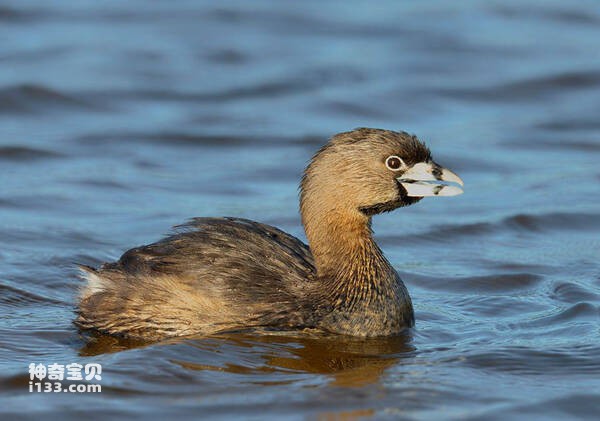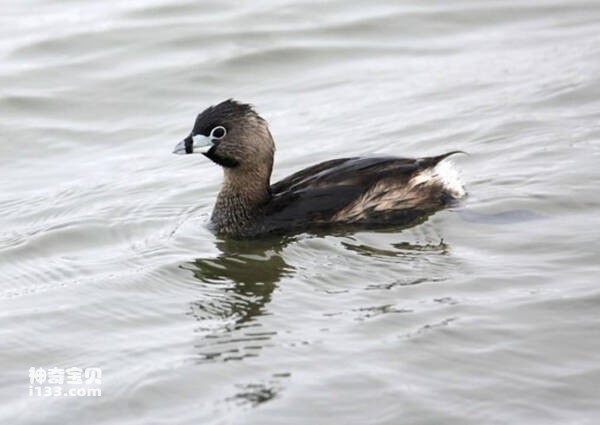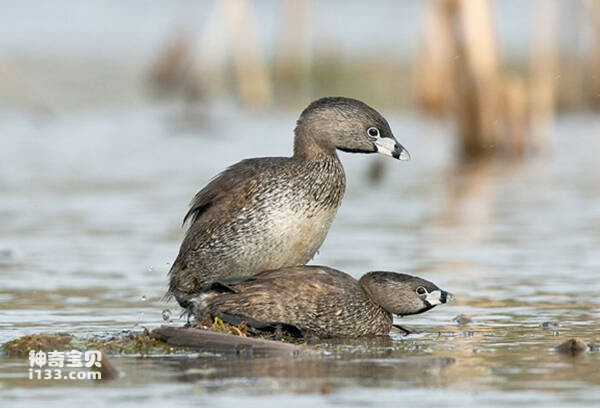Podilymbus podiceps
IUCN
LCBasic Information
Scientific classification
- name:Podilymbus podiceps
- Scientific Name:Podilymbus podiceps,Pied-billed Grebe
- Outline:Waterfowl
- Family:
Vital signs
- length:31-38CM
- Weight:339-568g
- lifetime:No textual research information is available
Feature
The neck is short, the head is large, the rump is tufted with white feathers, and the beak is thick and short and conical
Distribution and Habitat
Breeding grounds: Bermuda, Canada, Jamaica, USA and Uruguay.
Place of origin: Anguilla, Antigua and Barbuda, Argentina, Aruba, Bahamas, Barbados, Bolivia, Bonaire, Saint Eustatius and Saba, Brazil, Cayman Islands, Chile, Colombia, Curacao, Cuba, Dominica, Dominican Republic, El Salvador, French Guiana, Guatemala, Guyana, Haiti, Honduras, Martinique, Mexico, Montserrat, Nicaragua, Panama, Paraguay, Peru, Puerto Rico, Saint Kitts and Nevis, Saint Kitts and Nevis, Saint Lucia, Saint Martin (France), Saint Vincent and the Grenadines, Saint Martin (Netherlands), Suriname, Trinidad and Tobago, Turks and Caicos Islands, Bolivarian Republic of Venezuela.
Resident birds: Virgin Islands. Non-breeding places: Belize, Costa Rica and Ecuador. Traveler: Saint Pierre and Miquelon Islands.
Seasonal uncertainty: St. Bartholomew's Island. Wandering (non-breeding grounds) : Guadeloupe.
Occasionally: France, Grenada, Iceland, Ireland, Netherlands, Norway, Poland, Portugal, Spain (Canary I
Appearance
Great Grebe has a body length of 31-38 cm, a wingspan of 56-65 cm, and a weight of 339-568 g. It's a small water bird. Male and female are similar and do not show sexual dimorphism. The neck is short, the head is large, the rump is tufted with white feathers, and the beak is thick and short and conical. The upper body plumage of the winter adult bird includes gray or dark brown on the top, back and forehead, light brown on the sides, white on the lower body, reddish-brown on the cheeks and neck, black on the forehead and throat, with white eye circles, and a light-colored beak without black bands. During the breeding season from February to September, the throat is black and the beak is white, surrounded by a thick vertical black band. The subadult bird resembles the winter plumage of the adult bird, but has brown and white stripes on the cheeks, and the yellow-brown beak lacks a black band.
Details
The great Grebe (Podilymbus podiceps), known as Pied-billed Grebe, has three subspecies.

The Great Grebe is the most common grebe in the New World and the most familiar in the temperate regions of North America. In flight, is the typical grebe silhouette, with a straight neck, slightly drooping half-webbed and rapidly flapping wings. Far less sociable than most grebe, the species almost never congregated, sometimes only found in small marshy ponds. When disturbed, it may sink slowly until only the head is exposed to the water. Flight is rarely seen. It is usually hidden in swamps during the breeding season and produces a strange harsh or hoarse sound by day or night.
Great Grebe can be found in both fresh and saltwater habitats. They have a lovely habit of carrying their newly hatched chicks on their backs. Avoid predators by diving or sinking.

Food varies by location and season. They basically feed on fish. Like other grebes, they often dive for fish and will eat most small aquatic life in their habitat. Food includes fish (carp, catfish, etc.), insects (dragonflies, ants, etc.), crustaceans and amphibians (frogs, tadpoles, etc.). They also eat small amounts of aquatic plants.
Grebe can breed from early spring to mid autumn where the climate permits, and may have a long breeding season. Courtship is less ritualized than most grebes and involves a lot of summoning, sometimes duets. The nesting site is located in the shallow water of the marsh, near the opening, so that the birds can approach the nest underwater. Nesting is carried out by both sexes, collecting plant materials, consisting of spirulina plants or reeds. The nest is piled up from the bottom of the aquatic plant, floating and fixed to the standing vegetation. There are 4-7 eggs laid per litter, but there are also 2-10 eggs, which is less common. Eggs are pale blue-white with brown markings. Both sexes are involved in hatching, with the female doing more. Incubation period is about 23 days. Young birds can swim soon after hatching, and they are fed by both parents, often riding on their parents' backs when they are young. The adults carry their young on their backs and swim on the water. The age of the first flight is not known. One or two litters are produced a year, possibly more in the south.

Although population trends are unknown in some regions, overall population trends are stable. As of 2016, the species' growth in North America over the past 40 years has been small or statistically negligible (data from the Breeding Bird Survey: Butcher and Niven 2007). Note that these surveys cover less than 50% of the species' overall distribution range in North America.
Listed in the International Union for Conservation of Nature Red List of Threatened Species (IUCN) for 2016 ver 3.1 - Not Threatened (LC).
Protect wild animals and eliminate wild meat.
Maintaining ecological balance is everyone's responsibility!








